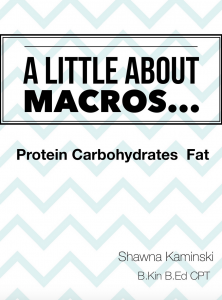 Food is our fuel and it comes in the form of three macronutrients:
Food is our fuel and it comes in the form of three macronutrients:
- Proteins
- Fats
- Carbohydrates
Some would say that alcohol is the fourth ‘macro’. It’s an element in our nutrition that is processed very differently than other macros so it’s in a class all of it’s own.
This is a quick guide to explain the role of each macro-nutrient and examples of each. Our body needs each ‘macro’ in varying quantities; we should never completely eliminate a macro-nutrient from our diet.
Protein
- Building blocks for the body
- Composed of amino acids
- There are 8 essential amino acids &11 non-essential amino acids
- Complete proteins contain all 8 essential amino acids
- Food source proteins take approximately two hours to digest
- All sources are 4 calories per gram
Fun facts about protein: it helps stabilize blood sugar, an active person needs between .7-1.2 g of protein per pound of body weight.
Fats
- Saturated fats are solid (butter, shortening, animal fat)
- Monounsaturated fats are liquid (vegetable oil, olive oil, etc.)
- Polyunsaturated fats are liquid (flax oil, fish oil, etc.)
- Trans fats are altered vegetable fats (hydration)
- Essential fatty acids cannot be produced by the body
- Required for optimal health, weight regulation, body function
- They include omega 3 and 6 fats (fish, flax oil/seeds, nuts)
- Digests in 3-5 hours
- 9 calories per gram
Fun facts about fats: combining fat and carbs together is the BEST formula for fat gain, most of us are omega 6 dominant and require more omega 3 fats, the keto diet was first created to control epilepsy seizures.
Carbohydrates
Primary source of energy
- Protein sparing (your body will use muscle for it’s energy needs when necessary)
- Simple carbohydrates are short chain sugars
- Complex carbohydrates are long chain sugars
. All carbohydrates are sugar of some sort.
. All carbohydrates elicit an insulin response.
- Different carbohydrates digest at different rates
- All carbohydrates are approximately 4 calories per gram
- CHOOSE STARCHY CARBS EARLIER IN THE DAY WHEN INSULIN RESISTANCE IS LOWER
- CHOOSE FIBROUS CARBS AFTER 6 PM
Fun facts about carbs: for every gram of carbohydrate you ingest, your body holds onto 3-4 grams of water so if you have a treat meal, it may seem like you’ve gained a lot of weight, conversely, if you lower your carb intake, it may seem like you’ve lost a lot of weight quickly.
The Role of Insulin
- Insulin can be manipulated for optimum benefit
- Carbohydrates elevate blood sugar
- Insulin is released to lower blood sugar.
- Insulin enables the body to use carbohydrates 3 ways:
- -as an immediate energy source
- -stored in muscle as glycogen
- -stored as body fat
- Avoid insulin spikes
- Insulin is fat sparing
- Body prefers glucose over fatty acids for energy source
- Elevated insulin stimulates the accumulation of body fat
- Insulin is very anabolic.
- A good time to have an insulin spike is after a workout so that carbs and protein can be shuttled into cells for replenishment of energy stores and muscle growth and repair.
There’s a specific method to determining the right macros for each individual based on a number of factors, including activity, gender, height, weight, age etc. Other factors like work environment, stress, genetics etc also play into determining what’s right for you.
The general settings on My Fitness Pal and websites like IIFYM (If It Fits Your macros) are templates based on large populations and are not necessarily accurate.
If you’d like more info on what YOUR macros are, let’s talk about it. Reach out to me or fill in this questionnaire.




